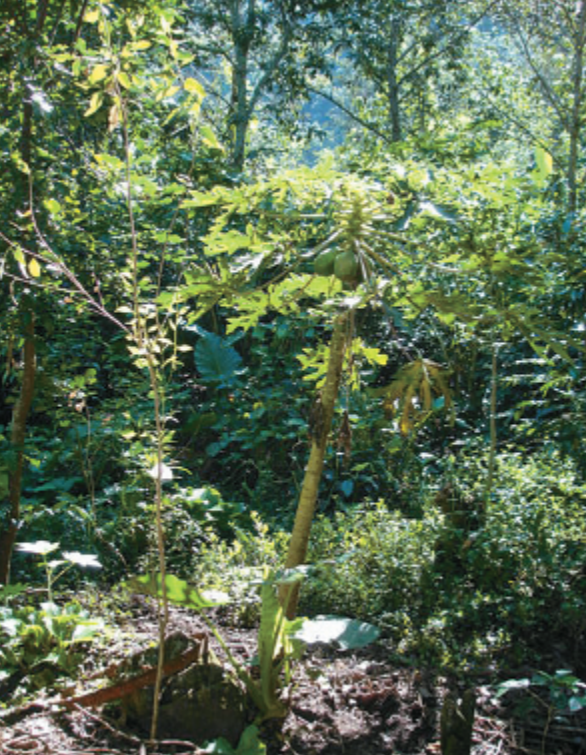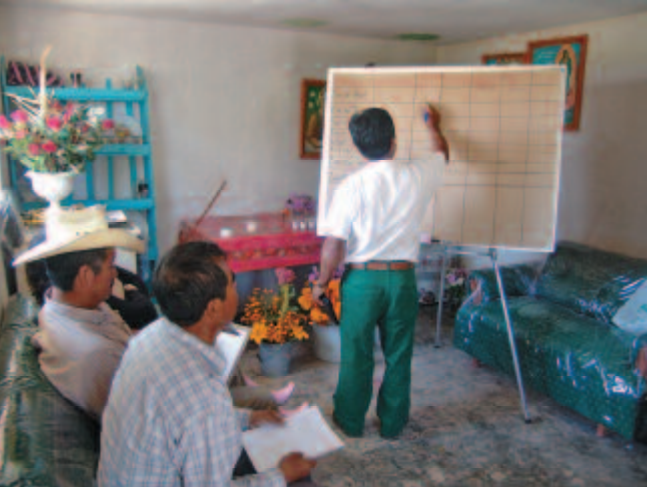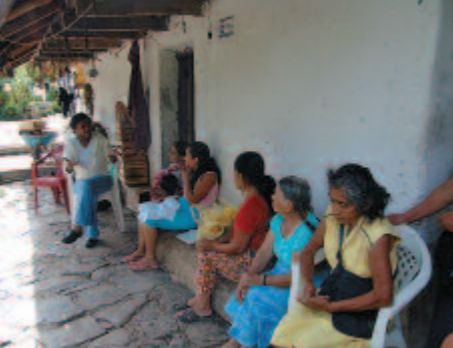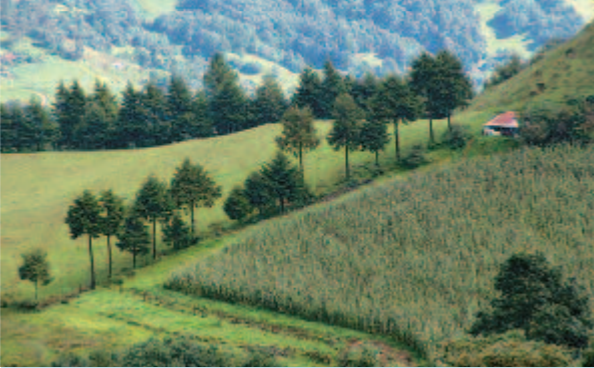Overview
In the State of Hidalgo (Mexico), a participatory approach to forest restoration was launched with the objective of recovering the productive capacity of forests, which is essential for biodiversity conservation and for the economic well-being of local communities. Hidalgo, with a population of 2,354,885 inhabitants, covers an area of 20,987 km2 in the center of the country. It has a wide variety of ecosystems in tropical, temperate and semi-arid climates. Poor management of natural resources has caused various degrees of disturbance in 292,000 ha of forested areas, resulting in 22,000 ha of fragmented rainforest and 31,000 ha of fragmented temperate and semi-arid forest. High rates of deforestation and forest degradation in Mexico’s rural communities have increased poverty and are causing rural populations to migrate to cities and foreign countries. The state of forest degradation, its causes and possible solutions were evaluated through regional and local community workshops. Criteria for selecting restoration techniques and plant species were based on the economic needs of the communities, known uses of the plants, seed availability, ecological function and site characteristics, among others. A total of 30 catalyst species and 23 rare species, all native, were selected for the four ecosystem types in the region. It was found that community members have a remarkable understanding of the state of local natural resources and that their participation was crucial to the success of restoration projects.
Quick Facts
Geographic Region:
North America
Country or Territory:
Mexico
Biome:
Temperate Forest
Ecosystem:
Temperate Forest - Deciduous
Area being restored:
200,000
Project Lead:
Centre for Forest Research (CIF) at the University of the State of Hidalgo (UAEH)
Organization Type:
University / Academic Institution
Project Partners:
- Florencia Montagnin - Yale University, School of Forestry and Environmental Studies, New Haven, CT USA
- Alfonso Suárez Islas & Maria Raimunda Araújo Santana - Universidad Autónoma del Estado de Hidalgo Instituto de Ciencia Agropecuarias y Centro de Investigaciones Forestales, Hidalgo, México
- Municipalities - Valle de Tulancingo and Otomí Tepehua regions: Santiago Tulantepec, Cuautepec, Acaxochitlán, Metepec and Tenango de Doria.
- National Forestry Commission (CONAFOR)
- Secretary of the Environment
- Association of Providers of Forest Services
- Local communities from the municipality of Tenango de Doria (Ejido Santa Mónica), three in communities in Huehuetla (San Guillermo, Cantarranas, El Paraíso), and two in Atotonilco El Grande (Ejido Zoquital, Ejido Sauz Xhate).
Otomí people participated at ejidos Zoquital and Sauz Xhate of Atotonilco el Grande, and Tepehuas participated in the workshops conducted in Cantarranas, El Paraíso and San Guillermo of Huehuetla.
Project Stage:
Planning / Design
Start Date:
2008
End Date:
2008
Primary Causes of Degradation
Agriculture & Livestock, Deforestation, Fire & Weather Events, Fragmentation, Mining & Resource ExtractionDegradation Description
The situation of forest degradation in the State of Hidalgo is common in much of Mexico. The annual rate of deforestation in Mexico from 2000 to 2005 was 0.4%, equivalent to 260 000 ha lost. Forest degradation is attributed to the expansion of agriculture and pasture lands and the increase in human population. For rural communities, which contain 80% of the forested land of Mexico, forest degradation has brought negative socioeconomic consequences, such as increasing poverty and resulting migration to cities and foreign countries. In Hildago, poor management of natural resources has caused various degrees of disturbance in 292,000 ha of forested areas, resulting in 22,000 ha of fragmented rainforest and 31,000 ha of fragmented temperate and semi-arid forest. This degradation altered the hydrological cycle, and induced a decline in biodiversity and productivity, and increased soil erosion.
Defining the Reference Ecosystem
The reference ecosystem is primarily based on contemporary reference sites or existing analogues of the pre-degradation ecosystem.Reference Ecosystem Description
The State of Hidalgo lies 60 km north of Mexico City. This project was carried out in 2,896,08 km2 in the south-eastern part of the state, covering two geocultural regions: the Valley of Tulancingo (municipalities of Tulancingo, Santiago Tulantepec, Cuautepec, Atotonilco El Grande and Metepec) and the Sierra Otomí Tepehua (municipalities of Acaxochitlán, Tenango de Doria and Huehuetla).
These municipalities represent most of the forested ecosystems in Hidalgo state. Temperate, semi-dry oak forests predominate in a transect running southeast to northeast; subhumid and humid temperate pine oak forests are located more to the east; temperate humid montane forests flourish at higher elevations and small fragments of secondary vegetation derived from perennial rain forest are observed at lower altitudes.
Project Goals
The project was initiated in order to gain a better understanding of the root causes of forest ecosystem degradation in the region, directly from the people involved in the problem.
- Identify the causes of destructive activities in the ecosystem, their repercussions for local communities and possible solutions.
- Select woody species with the greatest potential for use in restoring these forest ecosystems, based on traditional knowledge and the experience of local technicians and project researchers.
- Harmonize the rehabilitation of land productivity with environmental services, particularly the recovery of biodiversity.
- Use the information generated by this research is to form the basis for implementing research and disseminating restoration projects in the State of Hidalgo.
Monitoring
The project does not have a monitoring plan.
Stakeholders
The state of degradation, its causes and possible solutions in the communities were evaluated through participatory rural evaluation, interviews with key informants and focus groups, and periodic meetings with interested groups and training workshops.
Methods were focused on two levels of participation: a) regional – regional workshops and b) local – local community workshops.
The regional workshops were conducted in a town that was chosen to represent each of the regions studied, with the participation of municipal authorities and government institutions. The local workshops were held in communities or ejidos with the participation of local farmers and municipal authorities. Concepts relating to forest ecosystems and their degradation and restoration were presented in these workshops. An analysis of the causes, effects, and possible solutions to alleviate degradation of regional and local ecosystems was compiled after participants filled out a questionnaire. A workshop was held in each of the study regions, in which local authorities in rural development, forest ecology, and public protection participated. Communities with the most forest degradation were identified in these workshops, in order to select communities where the local workshops would be held.
How this project eliminated existing threats to the ecosystem:
In order to better understand the main threat to the forest system, workshops were held to listen to the opinions of people from both communities and local authorities in Hidalgo. The project worked with the local community to assess the causes of existing degradation threats to the ecosystem, and then develop strategies to remedy these threats. The causes and solutions were evaluated using participatory rural evaluation, interviews with key informants and focal groups, periodic meetings with interested groups, and training workshops.
How this project achieved a desirable species composition:
Some community members had already carried out reforestation projects, mainly under institutional programs where they did not take part in the planning and selection of species of interest.
A multi-pronged strategy was implemented to accomplish restoration goals. A seed collection program was established for the nurseries in cooperation with producers and project collaborators, in order to obtain seeds from high-value trees, such as cedar (Cedrela odorata) and walnut (Juglans mollis). Project collaborators were trained in nursery techniques and care so that they in turn could educate members of their communities on how to operate the nursery.
How this project recovered ecosystem functionality (e.g. nutrient cycling, plant-animal interactions, normal stressors):
This project aimed to rehabilitate lands suffering from deforestation and abandoned after intensive agriculture and ranching by implementing land use systems that are suited to the region, and to include, whenever possible, economically valuable native woody species. These appropriate land use systems were determined through the participatory methods with local communities.
Activities were undertaken to address any socio-economic aspects of the project:
The project used community participatory methods to evaluate restoration potential in Hildago. Tools used to encourage the participatory approaches included workshops with round-table discussions, rapid ecological assessments, and participatory community evaluations.
Ecological Outcomes Achieved
Eliminate existing threats to the ecosystem:
The municipal workshops determined that the principal causes of forest degradation are land use changes leading to soil degradation, overgrazing, forest fires, illegal logging and forest pests and diseases. This reflects the lack of zoning laws, forest stewardship and economic alternatives for the people of these areas.
Community members consider the principal causes of forest degradation to be illegal logging, forest fires, overgrazing and the presence of pests in the forests. They do not consider changes in land use as a factor in degradation. The perception of the population is that forest degradation began to increase during the 1980s with a decrease in the diversity and abundance of plants and animals, as well as in the number and volume of natural springs and water wells. Community members showed interest in participating in a planning exercise for the restoration of their degraded areas. The people represented their expectations for forest ecosystem restoration graphically. A planning proposal was drafted in these workshops, consisting of three steps:
▪ enumerating the necessary actions
for restoration;
▪ organizing them in a logical fashion;
▪ justifying the proposed actions.
The result of this planning was the discovery that it is necessary to consider the uses of native species in the different forest plantation systems.
Achieve a desirable species composition:
A preliminary selection of 30 catalyst species and 23 rare species was made for the four forest ecosystem types found in the study region. All of the selected species are native. Catalyst species pertain to early and intermediate succession stages, while rare species are from intermediate and advanced stages.
Farmers associated with this restoration evaluation project are participating in agroforesty techniques, planting several of the species recommended (above) for restoration in association with crops and fruit trees such as papaya.
Recover ecosystem functionality:
Information from community members with knowledge of the natural forest system and a literature review suggested potential systems to use for restoration: management of natural regeneration, forest plantations, enrichment plantings, stream restoration, and agroforestry systems. The most frequent attributes of the catalyst species were: erosion control, litter accumulation, rapid growth and habitat and food for wildlife.
Where possible, natural regeneration of the forests was encouraged. Project collaborators helped land owners and communities to identify important areas of natural regeneration.
Reestablish external exchanges with the surrounding landscape:
Tree regeneration in the understory was more successful beneath plantations than in abandoned fields – plantations can actually facilitate and encourage faster succession.
Factors limiting recovery of the ecosystem:
It is still too early to anticipate the success of these systems in achieving the objectives that were established by the researchers and the farmers. In addition, this is a dynamic process through which other species and restoration systems may later be identified.
During the workshops and field walks, it was recognized that producers needed training. Therefore, two courses in community nursery management were held and a small nursery with native species from oak forests was constructed.
Socio-Economic & Community Outcomes Achieved
Economic vitality and local livelihoods:
According to the evaluation of the two regional workshops with municipal authorities, the primary causes of forest degradation are land use changes leading to soil degradation, overgrazing, forest fires, illegal logging and forest pests and diseases. This reflects the lack of zoning laws, forest stewardship and economic alternatives for the people of these areas. The participating authorities identified 29 communities with serious forest degradation problems, as well as the causes of their deterioration.
Based on the results of the local community workshops, community members consider the principal causes of forest degradation to be illegal logging, forest fires, overgrazing and the presence of pests in the forests. They do not consider changes in land use as a factor in degradation. The perception of the population is that forest degradation began to increase during the 1980s with a decrease in the diversity and abundance of plants and animals, as well as in the number and volume of natural springs and water wells.
Community members showed interest in participating in a planning exercise for the restoration of their degraded areas. The people represented their expectations for forest ecosystem restoration graphically. A planning proposal was drafted in these workshops consisting of three steps:
▪ enumerating the necessary actions
for restoration;
▪ organizing them in a logical fashion;
▪ justifying the proposed actions.
Several of the communities employed various methods to initiate forest restoration. Public and private lands were used in the efforts, although only local municipalities chose to set up plant nurseries. Measures to prevent illegal logging and fire were taken by implementing various forms of observation and reporting systems.
This project recognized that the success of forest restoration in Hildago depends on understanding the interests of the local community, there economic system, and the knowledge they hold. The ethnic composition of the municipalities is predominantly mixed Indigenous-European (mestiza), with a large segment of indigenous Otomí, Tepehua and Náhuatl groups in the municipalities of Huehuetla, Tenango de Doria and Acaxochitlán. The primary economic activities of these communities are agricultural (corn, beans, coffee and barley), cattle and goat ranching, and forestry, primarily with the following timber species: Pinus spp., Quercus spp., Liquidambar styraciflua and Cedrela odorata. There are two types of property ownership in the study region: ejidos (collectively owned and managed lands in Mexico) and private ownership. Ejidos cover 300-500 ha. The average parcel of land managed by each family in the ejidos is 2.04 ha. The political organization of the municipalities is represented by a mayor and municipal secretary. Agrarian governance systems consist of the ejido commission and rural producer organizations, which represent a form of authority in specific branches of agricultural production.
Provision of basic necessities such as food, water, timber, fiber, fuel, etc.:
The native woody species selected most often have multiple uses besides restoring the natural forest system: firewood, construction, medicine, honey and timber for the catalysts; timber, ornamental uses, medicine, firewood and construction for the rare species.
Cultural dimensions such as recreational, aesthetic and/or spiritual:
During training exercises with the local community regarding restoration and nursery management, it was observed that learning the methodology has a role in developing people's self-esteem, because it gives value to their experience and knowledge. For this reason, the use and pursuit of this knowledge by researchers is of fundamental importance in identifying the course of action to be taken in the field.
Key Lessons Learned
- The most important decision in the planning of any plantation forest, whether the objectives are industrial, social or environmental, is the selection of the appropriate available species that will grow well in the site.
- The knowledge of rural populations is often an untapped mine of experience and wisdom on the management and use of natural resources. This knowledge should be incorporated into the technology used to resolve the current ecological crisis.
Long-Term Management
The use of participatory methods brought an understanding of the relationship between rural communities and the degradation of forested ecosystems. Local farmers and forestry and agricultural personnel possess a huge amount of knowledge about local woody species that should be utilized in future forest ecosystem restoration projects. Community members know and understand the state of their natural resource base and are therefore seeking enduring solutions for future generations.
Future research and restoration activities are needed in the State of Hildago, but they must involve community participation. Furthermore, the long term success of restoration in Hildago depends on the integration and communication of restoration efforts and long term work plans between municipal authorities and local communities.
It is suggested that researchers take a more active role in community development while remaining sources of objective information. Once researchers establish a relationship with the communities, there may be opportunities for them to carry out long-term research projects in cooperation with those communities, which could be beneficial for both parties.
Other Resources
Montagnini, Florencia & Suárez-Islas, A & Araújo Santana, M. (2008). Participatory approaches to ecological restoration in Hidalgo, Mexico. Bois et Forets des Tropiques. 295. 5-20.





